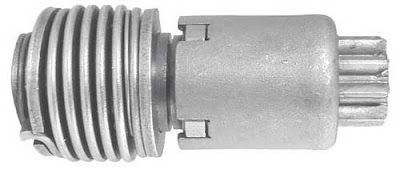TYPES OF DRIVE ARRANGEMENTS
The drive arrangements may be of the two general types:- Bendix drive
- Folo-Thru drive
Bendix Drive
Construction
The Figure shows the Bendix drive for starting the motor. It is fastened in the armature shaft of the starting motor. The drive head is keyed to the end of the armature shaft. The pinion gear, which has internal threads, is mounted on a threaded sleeve, just like a nut on a bolt. The sleeve is not connected directly to the shaft of the starting motor but uses it only as a bearing. A spring is attached on the drive head and also to the sleeve. |
| Bendix drive |
Operation
When the starting motor is at rest the pinion gear is not engaged with the flywheel. When the starting motor is switched on, the armature starts to rotate. This causes the threaded sleeve to rotate also because the sleeve is fastened to the armature shaft through a spring. The pinion, because of its inertia of rest and its unbalanced weight, turns very little, but it moves forward on the revolving volt until it engages with the teeth of the flywheel. The slight turning of the pinion gear helps to engage it properly with the flywheel. When the pinion gear strikes with the collar, it begins to turn with the sleeve, causing the flywheel to run with it. When the flywheel turns, the crankshaft also turns and the engine starts. The spring between the armature shaft and the threaded sleeve takes the shock of the start. |
| Bendix drive |
After the engine has started, the pinion gear is turned by the engine much faster than when rotated by the starting motor. This causes the pinion gear to turn back on the threaded sleeve, making it disengaged with the flywheel.
Watch the Bendix drive pinion arrangement below:
 |
| Bendix drive |
FOLO-THRU DRIVE
Construction
The Folo-thru drive is almost very similar to the Bendix drive. The difference is that the Folo-thru drive keeps the starting motor engaged with the flywheel until the predetermined engine speed is reached, but in Bendix drive, it is not so. In the Folo-thru drive, the threaded sleeve is attached to the armature shaft through a spiral spring. A pinion is mounted on the threaded sleeve. The pinion gear base has two small spring-loaded pins-an anti-drift pin and a lock pin. The anti-drift pin is similar to the lock pin but has a stronger spring.The anti-drift pin rides on the anti-drift slope path on the threaded sleeve and it keeps the pinion from drifting into the ring gear up to when the starter is not in use. It imposes a fraction drag that holds the pinion gear in the disengaged position. The lock pin drops into a detent in the sleeve thread as the pinion moves out of the cranking position.
 |
| Folo-thru drive |
 |
| Folo-thru drive |

ConversionConversion EmoticonEmoticon